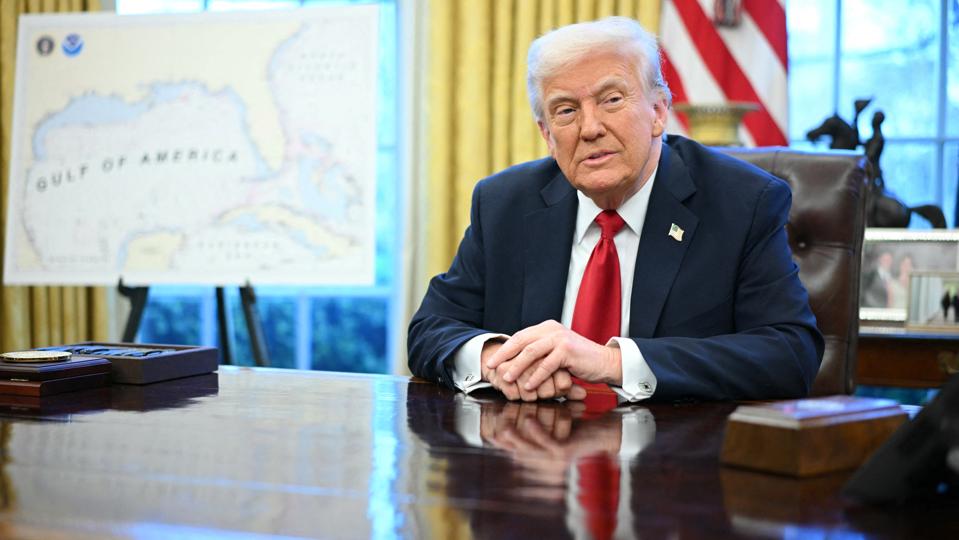Topline
The Trump administration’s multi-front tariff wars and escalating rhetoric are turning off international tourists, according to a growing body of travel data.
Key Facts
President Trump’s tariffs, imperialistic rhetoric and viral headlines of foreigners with legal tourist visas and green cards being detained by U.S. immigration officials are “stacking up as significant hurdles for the U.S. travel industry” and “setting international travel back several years,” Adam Sacks, president of Tourism Economics, a nonpartisan Oxford Economics company tracking tourism statistics, told Forbes.
While Tourism Economics’ end-of-2024 forecast had projected 9% growth for international inbound travel to the U.S. this year, the organization has revised its baseline forecast for a year-over-year drop of 5%—”but we recognize that it could be well worse than that, as things continue to unfold,” Sacks said.
Tourism Economics is forecasting total U.S. travel spending, representing domestic and inbound spending combined, will be 3.7% lower than its original prediction from December, amounting to an estimated $64 billion loss this year for the U.S. economy.
Inbound travel from Canada and Mexico are particularly important, accounting for 36 million tourists in 2024 and representing roughly half of all foreign travel to the U.S.
Airline bookings from Canada to the U.S. are down 70% compared to the same period last year, OAG, a global air traffic data provider, announced Wednesday.
After the U.S. Travel Association (USTA) warned in early February that even a 10% reduction in Canadian inbound travel would translate to $2.1 billion in lost spending and would jeopardize 140,000 jobs in the hospitality sector, preliminary data from Statistics Canada for February showed a 23% drop in cross-border car travel from Canada to the U.S.
Key Background
Historically, there has always been a correlation between international sentiment toward the United States and inbound travel demand. “During the first Trump term, we saw some pretty dramatic changes in performance for U.S. inbound and those changes were from those exact markets where policy and rhetoric were in play,” said Sacks, noting that, prior to Trump’s first term, inbound travel had been on the rise from countries like Mexico, China and the Middle Eastern Muslim countries, but then fell over Trump’s first three years after those countries were targeted with aggressive rhetoric. “These major turns in performance can be connected to unpopular policy and rhetoric as we look at data on travel intentions, cancelations, trip sentiment toward the U.S., as well as forward bookings and the pace of air travel bookings. What we’re looking at now is a situation that is considerably worse than what we saw during Trump’s first term.”
What We Don’t Know
Will anti-U.S. sentiment negatively impact international visitation for upcoming marquee sporting events such as the 2025 Ryder Cup, 2026 FIFA World Cup and 2028 Olympic and Paralympic Games? “We’ve seen this over the last 25 years whenever, whenever the U.S. has policy that is unpopular in Europe, it does affect European travel to us,” Sacks said. “We saw it during the Second Gulf War, which was highly unpopular in Europe. But what we’re seeing now is orders of magnitude worse, as far as basically treating Europe as if they are our adversaries and so it comes into play with the trade war where everything is considered a zero-sum game.”
Crucial Quote
“The administration is committing unforced error after unforced error in the international tourism space,” Sacks said. “There’s literally nothing to be gained from the sort of adversarial posturing that the administration has taken toward Canada. The same would be true of Europe, when Trump says that the European Union was formed in order to screw the United States. Nothing to be gained from that.”
Tangent
After Canada, Mexico is the second biggest source of inbound tourism to the U.S. after Canada. Prior to the escalation of tariff threats, the USTA projected an 18% increase in Mexican visitors in 2025 compared to 2024. Looking back to the first half of Trump’s first term, the US saw a 3% decline in visitors from Mexico. But air travel from Mexico to the US fell 6% year over year in February, according to data from the National Travel and Tourism Office in the U.S. Department of Commerce, which is the official U.S. government source for travel statistics.
Further Reading
Germany And UK Warn Of Travel To US After Reports Of Detentions (Forbes)
Canadian Road Trippers Boycotting U.S. Could Mean A $4 Billion Economic Loss (Forbes)

